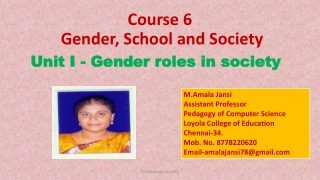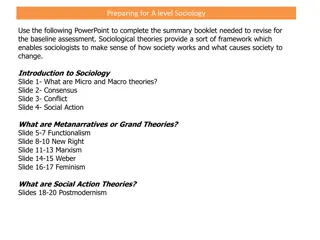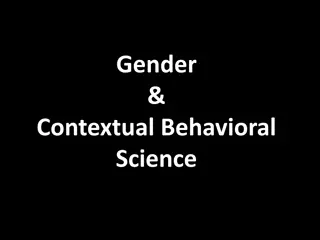Understanding Theories of Gender and Behavior
Explore traditional gender characteristics, past biological and sociocultural factors, current biological and societal influences, and individual traits that shape gender-related behavior. Discover how group-level factors and societal-environmental influences play a role in defining gender roles and behaviors.
Download Presentation

Please find below an Image/Link to download the presentation.
The content on the website is provided AS IS for your information and personal use only. It may not be sold, licensed, or shared on other websites without obtaining consent from the author. Download presentation by click this link. If you encounter any issues during the download, it is possible that the publisher has removed the file from their server.
E N D
Presentation Transcript
CHAPTER TWO THEORIES OF GENDER
Traditional Gender Characteristics Submissive-passive Dominant Independent Dependent Rational Emotional Assertive Receptive Analytical Intuitive- Brave Timid(lacking confidence) Active Insensitive Passive Sensitive
THEORIES OF GENDER Theories different levels of explanation to show behavior of women and men. GROUP-LEVEL FACTORS: o Group level process include biological & cultural evolution. o The level considers as we are a member of a group (either biological groups or a cultural group or ethnic group, religious group). of gender focus on four
PAST BIOLOGICAL & SOCIO- ENV TAL FACTORS: This level attempts to explain your gender-related behavior in terms of the past events that affect you. Past influence of biological factors (the genes you were born, parental hormones) and
Past (parental rearing or the way your parents treated you when you were young, peer influences, influences etc) may influence your current behavior as a man or woman. societal-environmental factors media
CURRENT BIOLOGICAL & SOCIAL- ENVIRONMENTAL FACTORS: This focus on current events that influence your behavior. Current Biological example, the way your brain cells are organized right now, your current level of testosterone(a male hormone) gender-related factors - for
and oestrogen (a female hormone), and the setting you are now in may affect your current gender related behavior. Current individual, a person you are with (girl friend or boy friend) can influence your behavior here-and-now, not in the past. social-env tal factors: as an
TRAITS RESIDING WITHIN THE INDIVIDUAL: This analysis your behavior in terms of your traits, intelligence, cognitive abilities and dispositions- factors that reside within you.
BIOLOGICAL THEORY Biological theories of gender argued that, there are differences between male and female, and that we may- to some extent be born masculine or feminine. The biological basis of sex differences is obvious for physical traits. some innate
MEN WOMEN Produce ova Give birth & lactate (produce milk) Their body produce more estrogen(female hormone) Have bigger hip & breast more body fat Women typically have less body hair than men do Produce sperm Do not Men s body produce more androgen(male hormone) Men have broader shoulder & more muscle mass than women do
Therefore, these difference mold their behavior.
EVOLUTIONARY THEORY This theory use Darwin s theory of evolution as framework. The basic assumptions of Darwin s (1859) original theory of evolution are simple: The traits of all variation an organizing living things show
Traits can be passed from generation to generation (principle of inheritance or heredity). Natural selection is the Filter that determines which traits are passed from generation and to generation. The principle of Darwin s theory proposes that: it is the organism s env t that selects which traits are passed from generation. natural selection generation to
According to Edward O.Wilson(1975,1978), Hominid women were responsible for bearing, nursing, & caring for children, they evolved to be more nurturing. And because men were responsible for hunting and fighting, they evolved more aggressiveness & better visual- spacial ability.
Generally, describes how traits are selected based on their adaptiveness environments. Evolutionary theory of gender proposes that, because of difference between male and female reproduction, women evolved to different reproductive physical & behavioral traits. evolutionary theory , in particular men somewhat strategies and have and
SOCIAL LEARNING THEORY Biological possibility between men and women may be innate . In contrast, social argue that the differences are learned. According to the Albert Bandura & Walter Mischel (1999, 1966), the differing behaviors of women and men can best be explained in terms of well-understood principle of learning such as: theories that entertain some the differences learning theories theorists such as
Classical conditioning Operant conditioning Modeling Classical conditioning: According to Walter Michael (1966), classical conditioning helps explain why labels like sissy pansy tough or sweet acquire d/t values for the two sexes.
The word sissy is usually used to ridicule a boy, and because it is associated with events that trigger shame & disgust, it becomes a very unpleasant labels for most boys. A boy will not want to loathing in him. Boys often are unwilling to engage in girlish activities such as playing with dolls, playing house & dress up .
According to Michael, this may be because boys are conditioned to have horrible feeling activities. Operant conditioning: This kind of conditioning occurs when voluntarily (consciously controlled & chosen) behaviors rewards and punishment. about some such are molded by
Social learning theorists argue that boys and girls rewarded and punished for different kinds of behaviors throughout their lives. are systematically
Modeling: Finally, children learn to behave as boys or girls by observing & imitating the behaviors of learn to be male imitating same-sex parents , siblings, friends, and media figures. others. or Children female by
COGNITIVE THEORIES OF GENDER Social learning theories portray the learning of gender as a rather passive process. Girls & boys behave as conditioning, rewards and social models dictate. For human being, however, gender is In the mind as well as in the environment.
According cognitive theory of gender, becoming male or female is not just a matter of genes , hormones, and social conditioning. It also depends on how we view ourselves. For example: Children identify their sex by age 2 and 3 & they understand that people come into two varieties , male and female. At the same time, children understand the difference b/n male and female.
Therefore , they categorize themselves as male or female. Social learning theory argues for a different sequence: I want rewards, I m rewarded for doing boy things, therefore I want to be a boy But it is not rewards that masculine, according theory. make the cognitive boy to
Rather it is identifying oneself as male that make masculine rewarding. Cognitive theory sequence : I m a boy, therefore I want to do boy things, opportunity to do rewarding. activities assumes this therefore boy the things .is
SOCIAL PSYCHOLOGICAL THEORIES OF GENDER According this theory, the current setting is a major behavior. Gender stereotypes & beliefs also have an important role in many social psychological theories of gender. Stereotype is pictures that we carry around in our heads about social groups. cause of our
And it is probabilistic beliefs that w hold about groups of people. It is oversimplification of reality and it may cause us to overestimate the differences between groups and to underestimate the variability within groups. Stereotypes may perception. distort our
People hold strong stereotypes about the personality traits & roles possessed by men women. In most cultures , women & men occupy quite d/t roles. For exa: women are more responsible for child rearing, foraging and domestic duties. Men are more responsible for hunting, fishing, and in producing income. modern society ,
These role therefore, determine and people s stereotypes and men . Generally, social theories of gender power of the social setting to create sex differences and focus on gender stereotypes , their consequence. about women psychological emphasize the cause and
FUNCTIONALISM Functionalism is the view that society consist of institutions that serve vital purposes for people. Functionalist perspective sees society as a complex system whose parts work together to promote stability. Functionalism addresses society as a whole in terms of the function of its constituent elements customs, traditions, and institutions solidarity & namely: norm,
According to Herbert Spenser, these parts of society as organs that work toward the proper functioning of the body as whole. Functionalist perspective of gender inequality was articulated in the 1940s and 1950s and largely developed by Talcot Parsons.
This inequalities exist as an efficient way to create a division of labor. The division of labor(women take care of the home while men provide family) to maximize resources Therefore, according functionalist perspective, other social institutions, contributes to the maintain social order by providing & ensuring the stability of society as a whole. theory suggests that gender and efficiency. structural gender like
CONFLICT TEORY Social conflict is the struggle between two parties for power & status. Conflict theories draw attention to power differences , such as gender, class & race conflict, and contrast historically dominant ideologies. valued resource,
It is therefore, a macro level analysis of society that sees society as an arena of inequality that generates conflict and social change. Conflict theory look at how social patterns can cause some people in society to be dominant, and others to be oppressed.
Conflict theory of gender argued that, gender is best understood attempting to maintain privilege to the detriment of women. Conflict b/n the two groups caused things like the women s suffrage mov t & was responsible for social change. Thus, men become dominant group and women become subordinate group. as men power &
SYMBOLIC INTERACTIONISM Symbolic interaction , also known as interactionism. This theory emphasis on micro-scale social interaction to provide subjective meaning in human behavior, the social process and pragmatism. Theory sees society as the product of the every day intervention of individuals.
People interact in countless settings using symbolic communications. According to gender interactionists, gender stratification exists because people act toward each other on the basis of the meanings they have for each other, & that derived from social interaction. meanings are
Therefore, characteristics & practices are socially constructed, reproduced, reinforced through daily interaction. gender is the interaction. masculinity & feminity Thus, human result of
FEMINISM AND ITS BRANCHES FEMINISM: Is a collection of movements aimed at defining, establishing, and defending equal political, economic, and social rights for women. The theory focuses on how gender inequality shapes social life.
This approach shows how sexuality both reflects patterns inequality and helps to perpetuate them. Feminism, from perspective, focuses inequality and links sexuality to the domination of women by men. of social a social on conflict gender























